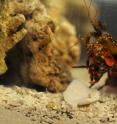Mantis shrimp inspires new body armor and football helmet design
RIVERSIDE, Calif. -- The mantis shrimp is able to repeatedly pummel the shells of prey using a hammer-like appendage that can withstand rapid-fire blows by neutralizing certain frequencies of "shear waves," according to a new research paper by University of California, Riverside and Purdue University engineers. The club is made of a composite material containing fibers of chitin, the same substance found in many marine crustacean shells and insect exoskeletons but arranged in a helicoidal structure that resembles a spiral staircase.
This spiral architecture, the new research shows, is naturally designed to survive the repeated high-velocity blows by filtering out certain frequencies of waves, called shear waves, which are particularly damaging.
The findings could allow researchers to use similar filtering principles for the development of new types of composite materials for applications including aerospace and automotive frames, body armor and athletic gear, including football helmets.
"This is a novel concept," said David Kisailus, the Winston Chung Endowed Professor in Energy Innovation at UC Riverside's Bourns College of Engineering. "It implies that we can make composite materials able to filter certain stress waves that would otherwise damage the material."
The "dactyl club" can reach an acceleration of 10,000 Gs, unleashing a barrage of impacts with the speed of a .22 caliber bullet.
"The smasher mantis shrimp will hit many times per day. It is amazing," said Pablo Zavattieri, an associate professor in the Lyles School of Civil Engineering and a University Faculty Scholar at Purdue University.
The researchers modeled the structure with the same mathematical equations used to study materials in solid-state physics and photonics, showing the structure possesses "bandgaps" that filter out the damaging effects of shear waves traveling at the speed of sound.
Source: University of California - Riverside
Other sources
- Armor Yourself In The Same Megatough Material As This Boxing Shrimpfrom PopSciThu, 18 Jun 2015, 22:00:12 UTC
- How mantis shrimps sparfrom Sciencenews.orgWed, 17 Jun 2015, 19:30:38 UTC
- Mantis shrimp inspires new body armor, football helmet designfrom Science DailyWed, 17 Jun 2015, 19:30:30 UTC
- Creature's 'dactyl club' filters shear waves to resist damagefrom PhysorgWed, 17 Jun 2015, 9:50:15 UTC

